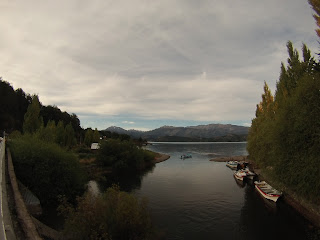Wednesday, April 3, 2013
Coyhaique a Puerto Rio Tranquilo
I had stayed in a hostel in Coyhaique to rest for a day met two good Germans and an Italian. The Italian was in his late 30s and had sold his possessions and quit his job and was exploring. The Germans owned the hostel and had arrived 13 years earlier when the town was dirt roads and horses. You could ride the whole Carretera Austral on horseback back then, and the entire Ruta 7 was ripio and all the bridges were wood and many river crossing were without the bridges. Now there are sections of pavement, although short, and most bridges are concrete. The Germans said Rio Tranquilo was the place they were to relocate--Coyhaique had grown too large and complicated.
I rode from Coyhaique and the terrain grew dry and began to mimic the pampa. I ran into Carlos, the first Chilean cyclist I have encountered on the ride, and we rode and reached mountains and a river and the temperature dropped and we camped along side a lake and ate toasted wheat flour and powdered milk mixed with river water. In the morning frost covered the bikes and the tents and at 1000 meters there was a difference in the mornings. We descended steep switchbacks until Villa Castillo, a town named after mountains that resemble castles. We inquired in several locations for bread, finally finding 5 day-old breads from a woman. There the ripio began again and the climbing was steep and brutal and the traffic heavy from Easter Sunday. That night we stopped in front of a house for water and entered the side yard to fill up, then camped across the house above a river and steep cliff. That night was much warmer, and the dinner consisted of tuna and pasta and the breakfast oatmeal. Carlos is a yerba mate drinker, which already makes him a fine man.
We rode brutal ripio the next day, climbing and ascending in the sun and passing lakes and lagoons and rivers and streams and waterfalls and rock formations. That night we camped in Puerto Murta, on a free municipal campground, seemingly unused and on Chile's largest lake, General Carrera, an enormous, blue, pristine body of clear liquid. Bread was again hard to find but we found an old woman right across from the camping who gave us a kilo of hot bread which was promptly destroyed by the collective appetite and then another kilo the next morning, in which I encountered the steepest road climbing in memory in difficult ripio yet all along the great Carrera lake.
Last night and tonight, a camping in Puerto Rio Tranquilo, a tranquil town on the great Carrera lake. The first night was passed with a Spanish couple and a 70-year old Canadian cyclist. The following day was passed with a newly married couple (man, from Cordoba, woman, Santiago) and a Uruguayan at dinner. I was instructed yet again in the ways of yerba mate from man from Cordoba and learned much from the man from Uruguay, a merchant marine. At dinner, we ate a dinner of polenta and later some artesenal cider from Valdivia.
On one side of the cordillera there is the pampa with its wind and beautiful desolation. On the other side there is a wet and pure paradise of glaciers, mountains, streams, lakes. The roads are mostly unpaved, the land mostly unpopulated. Yet the last roads out here end soon, soon down south, soon in Villa O'Higgins. Then there will be no choice but to return to the Pampa, to Ruta 40, to the wind.














































